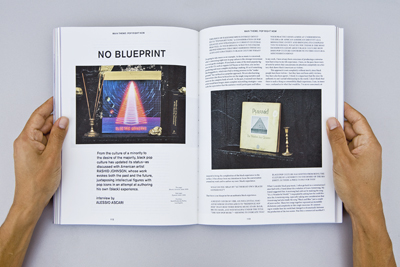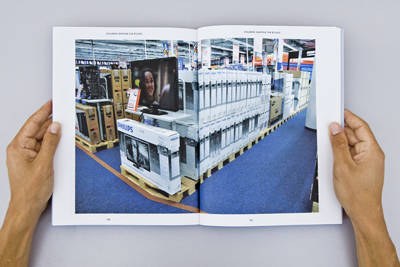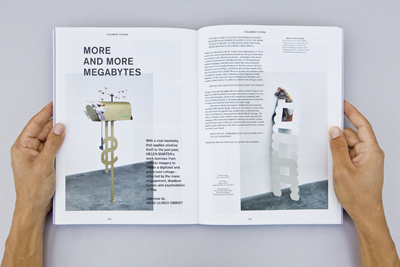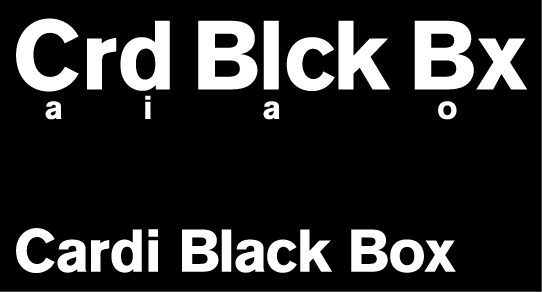ISSUE 11Summer 2011
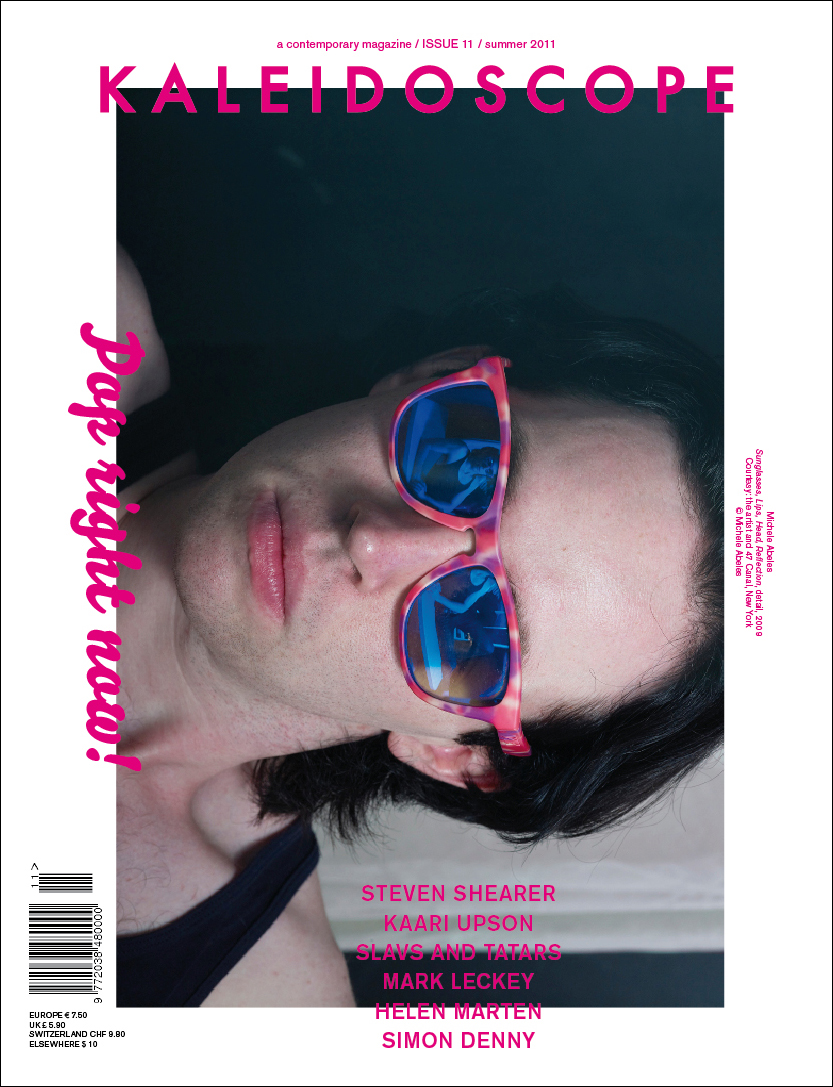
HIGHLIGHTS: Steven Shearer by Dieter Roelstraete; Slavs & Tatars by Carson Chan; Kaari Upson by Quinn Latimer; Alina Szapocznikow by Chris Sharp; Greg Parma-Smith interview by Nicolas Guagnini.
MAIN THEME: POP RIGHT NOW: Roundtable with Bettina Funcke, Massimiliano Gioni, John Miller, moderated by Joanna Fiduccia, with a postscript by Boris Groys, and artworks by Darren Bader; Justin Bieber by Francesco Spampinato; Rashid Johnson interview by Alessio Ascari; The Dark Side of Hipness Mark Greif and Richard Lloyd in conversation.
MONO: MARK LECKEY: Lost in the Supermarket by Barbara Casavecchia; The Browser Is a Portal by Isobel Harbison; Special Project by Mark Leckey; Art Stigmergy interview by Mark Fisher.
COLUMNS: PIONEERS: Morgan Fisher by Simone Menegoi; FUTURA: Helen Marten interview by Hans Ulrich Obrist; MAPPING THE STUDIO: Simon Denny by Luca Cerizza; CRITICAL SPACE: Douglas Coupland interview by Markus Miessen; ON EXHIBITION: Jeff Koons' "The New" by Paola Nicolin; LAST QUESTION: And What About Pop Music? answer by Scott King.
topPOST-WHAROLIAN MOURNERS
by DIETER ROELSTRAETE
STEVEN SHEARER, the representative of Canada at this year’s Venice Biennale, practices a dazzling pictorial experimentation engaged with a dense array of historical styles, from Impressionism to Expressionism, Fauvism, and Symbolism, while exploring the codes of suburban American pop culture.
Window, 2005
Courtesy: Stuart Shave/Modern Art, London,
Galerie Eva Presenhuber, Zurich,
Galleria Franco Noero, Turin,
Gavin Brown, New York
Through no fault or design of my own, a chance visit to Minneapolis provided just the right inspirational occasion for jotting down a few thoughts on the new and not-so-new work of Vancouver-based artist Steven Shearer (b. 1968), whose drawings, paintings, and sculptures will occupy the Canadian Pavilion during this summer’s Venice Biennale. The occasion in question was an exhibition titled “The Mourners,” which I was fortunate enough to see at the Minneapolis Institute of Art. The exhibition’s titular grievers are a group of thirty-eight small alabaster sculptures, made in the fifteenth century by some of Europe’s finest stone carvers to adorn the graves of the Dukes of Burgundy: a procession of mournful, dejected looking monks, many with their hoods pulled over their contorted faces, languorously shuffling in and out of the labyrinthine structure (meant to evoke the entrails of a medieval Carthusian cloister) that forms the pedestal on which the life-size sculpted effigies of the ducal deceased lie enshrined.
Although I first got to know these extraordinary (and extraordinarily expressive) sculptures through a book that was given to me as a birthday present by another artist friend, upon seeing this morbid sepulchral extravaganza, my thoughts quickly wandered off to Steven Shearer’s studio—and they did so not just because “mournful,” “dejected,” “contorted,” “heretical,” “languorous,” “morbid,” and “sepulchral” are adjectives that are often (and, it should be added, often too easily) applied to Shearer’s own work.
topPOP RIGHT NOW
BETTINA FUNCKE, MASSIMILIANO GIONI and JOHN MILLER moderated by JOANNA FIDUCCIA with a postscript by BORIS GROYS and artworks by DARREN BADER
As we witness the unprecedented destruction of public space through digital media, the embrace of art and popular culture has grown increasingly complicated—demanding that its core contradictions be explored to unveil Pop’s enigmatic and ambivalent nature, and to discover how its legacy plays out in contemporary practices.
JOANNA FIDUCCIA: I want to begin today by speculating on the title of this roundtable, “Pop Right Now.” By virtue of addressing “right now,” the topic seems to suggest a notion of Pop untethered from its historical figures. To be “Pop,” then, becomes something akin to being “hip”—a value that lives and dies in its moment, and that is, moreover, non-genealogical. “Pop right now” looks to be less about a legible legacy of Pop art than about a set of tactics or maybe attitudes. I wonder how the title “Pop Right Now” struck you. For instance, Bettina, you have an investment in seeing how some of Pop’s core contradictions and aporia play out in contemporary practices, whereas John, many of your works engage commodity and taste in ways related to Pop operations, and Massimiliano, as a curator in a contemporary institution, you are perhaps living out certain ramifications of Pop on art’s relationship to the public sphere today.
topART STIGMERGY
interview by MARK FISHER
In an increasingly dispersed world, MARK LECKEY rejects the self-referentiality of the art world in favor of being immersed in things through the benefits of technology— thus allowing an expanded field of sculpture to take shape between material and immaterial realms.
Drunken Bakers, video still, 2005
Courtesy: the artist and
Gavin Brown’s enterprise, New York
© Mark Leckey
MAYBE WE COULD START OFF BY TALKING ABOUT THE ROLE OF POPULAR CULTURE IN YOUR WORK. WHY DO YOU FOCUS ON POPULAR CULTURE?
Popular culture is just things that are immediate to me. When I was in college in the ’80s, I found everything too detached or ironic, and I didn’t want to make work like that; I couldn’t make work with a critical disinterestedness. I decided that I should use as material my own history and background. “Fiorucci” was a way of digesting things that had happened to me personally, but also a history of where I had come from. I was a casual and a raver, so those are things I can speak of. My show at the Serpentine features a big fridge because that’s what is now in my local environment: domestic appliances. That’s what I have a relationship with now.
Read more

